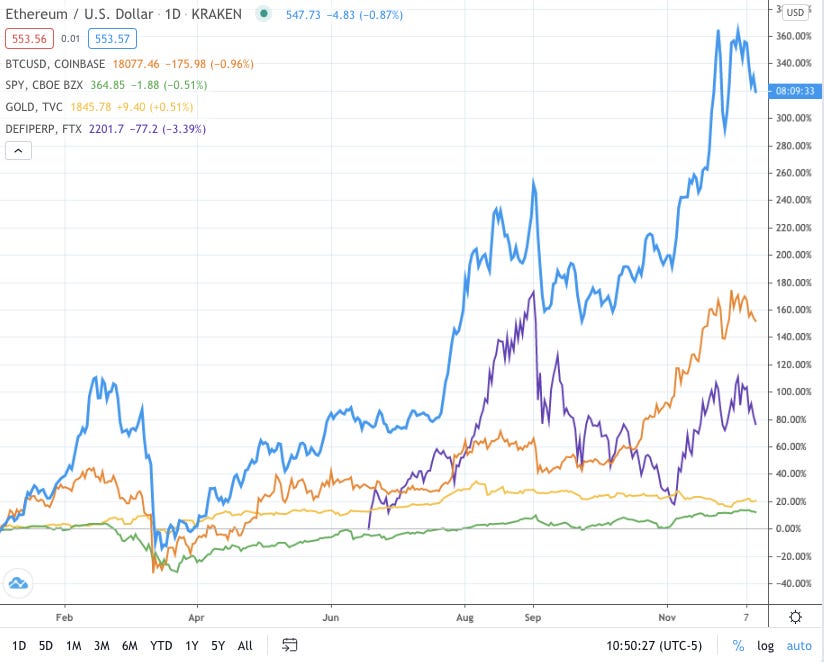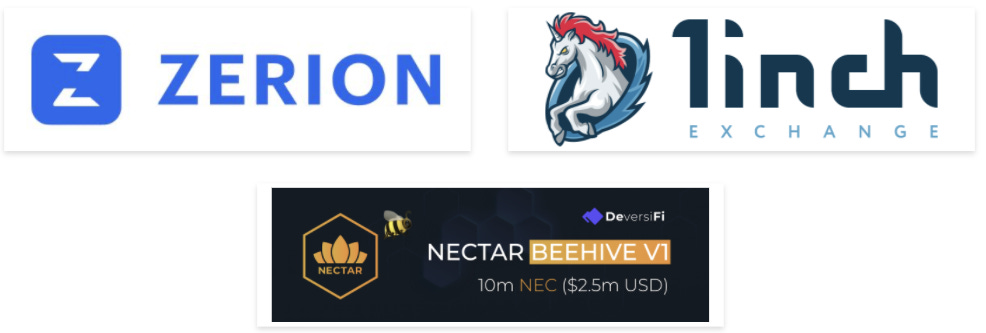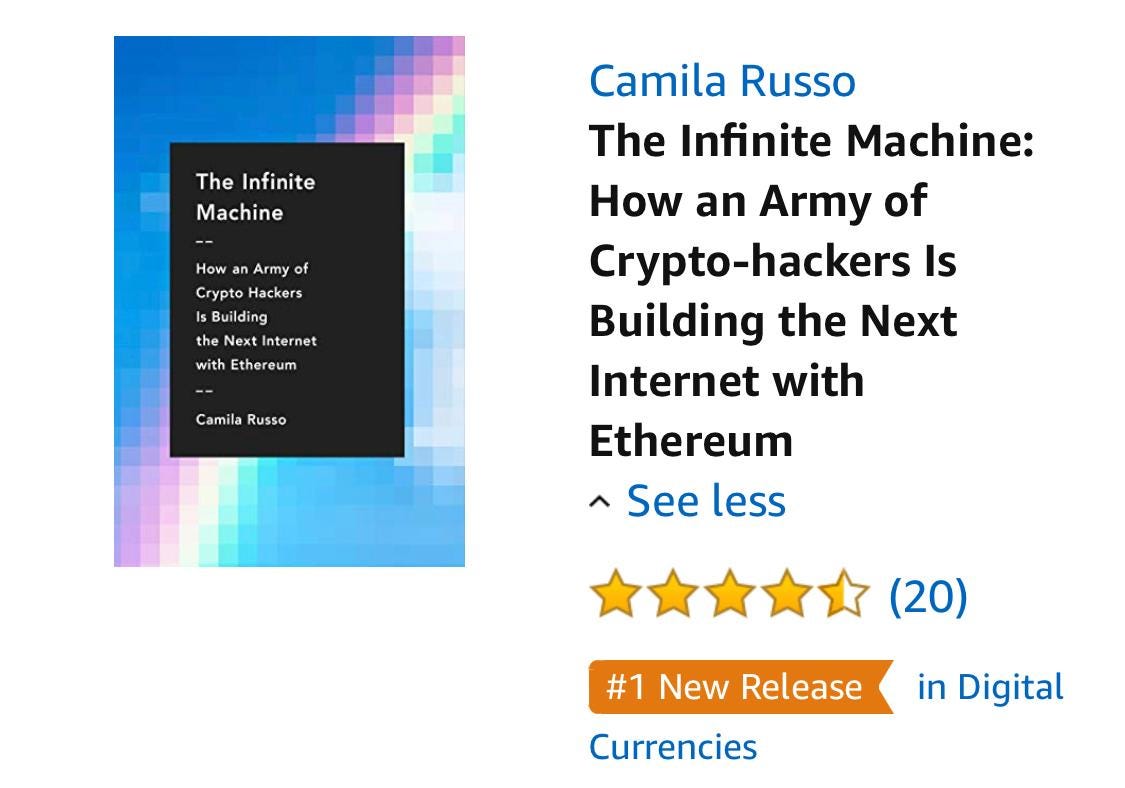"DeFi Returns are Eating Traditional Finance," by TrustToken's Rafael Cosman
Hello Defiers and happy Friday!
Ether is up 320% so far this year, Bitcoin is up 160%, and DeFi, as measured by FTX’s index, is up 80%. This compares with a 10% increase in US stocks and 20% in gold.
While cryptocurrencies offer distinct advantages over traditional assets —portfolio differentiation, always-on market, instant settlement — what will really move the needle for institutions is returns that are not in percentages, but in multiples, argues TrustToken CEO Rafael Cosman. It’s already happening with BTC. Bitcoin was still a Wild West for institutions in 2017, but now that the infrastructure is in place, they are falling over themselves to invest.
The same will likely happen with DeFi, Cosman writes, together with TrustToken marketing head Michael Gasiorek. But the unicorn-themed protocols and degen farmers won’t need to put on a suit and tie to great this new cohort of investors. Instead, they will have to adapt. And if they don’t, they’ll get left behind.
Read more below :)
👀 BTW: Be sure to tune in today at 5pm EST to ACJR’s Meetup #2: How to Build an Audience with Leigh Cuen, Janine Romer and The Defiant’s own Camila Russo.
SIGN UP HERE
Both paid and free subscribers receive full guest posts, but paid subscribers get them early. Paid subscribers also get complete access to The Defiant content and archive, and access to The Defiant Discord chat. Join the club! Subscribe now at $10/month, $100/year clicking on the button below, or pay with Dai on this link.
💗 Contribute to The Defiant’s Gitcoin Grant Here: Huge thanks to the 87 contributors so far. Right now 1 Dai is being matched by 33, and 10 is being matched by 88! Your support for DeFi-focused journalism makes a huge difference.
📺 Watch the latest on The Defiant’s YouTube: 5 Things to Watch in 2021!
🎙Listen to this week’s podcast episode with Gnosis’ Stefan George:
🙌 Together with Zerion, a simple interface to access and use decentralized finance, 1inch.exchange v2, which aims to provide the best rates by discovering the most efficient swapping routes across all leading DEXes, and DeversiFi's Nectar Beehive V1, which allows traders to provide liquidity & earn Nectar ($NEC) tokens.
DeFi Returns are Eating Traditional Finance
By: Rafael Cosman and Michael Gasiorek of TrustToken
Bitcoin has come a long way since its 2008 start as a seemingly innocuous nine-page whitepaper. Today, BTC has become the most famous digital cash alternative, enjoying fresh all-time highs and regular mainstream press coverage. Satoshi may have designed Bitcoin to allow individuals to transact without needing banks, but now the same industry that maligned it as “rat poison squared” is falling over itself to load up on Bitcoin.
Since 2017, digital assets have experienced rapid adoption, moving from cypherpunk IIRC chats to mainstream financial portfolios, often supported by a new generation of institutional-grade, crypto-specific service providers taking on the complexity (and utility) of being one’s own bank out of the equation.
As demand for crypto assets flows from the average consumer to their financial advisor, institutions are learning they better have a way to offer their clients exposure to digital assets - or risk getting fired.
However, the institutional adoption of cryptocurrencies, starting around 2018, would be just the first wave of blockchain eating up traditional finance.
The Second Wave Coming at Traditional Finance: DeFi
2020 has undeniably been crypto’s year of decentralized finance, or DeFi. Offering much more sophisticated financial opportunities than simply holding digital assets and hoping for the best, DeFi has brought lending, borrowing, derivatives and so much more on-chain, all with little to no barrier to entry. Even we’ve gotten into the game, building a protocol for uncollateralized lending - and in our experience, the innovation across DeFi is just beginning.
The same can be said of DeFi’s adoption, also at its nascent stage. These days, DeFi’s most active users range from deeply technical smart contract specialists to “DeFi degens,” those brave (sometimes foolish) gamblers and enthusiasts who take the highest risks and greatest rewards in being the first to try a new, often unaudited earning opportunity.
DeFi today is not dissimilar to Bitcoin in 2017: an industry largely outside the financial system, acting as a sort of unregulated Wild West, offering up rewards as high as the risks. Just like Bitcoin in 2017, DeFi today is missing a powerful ally: institutional money managers.
So, will DeFi need to clean itself up, put on a suit, and cut down on its risk-seeking behavior to sit down with institutional investors? Or will institutions need to get hip to the tech, trends, and culture of DeFi to capture its upside?
Money Seeking Value
To start answering this question, consider how much Bitcoin had to change to become the new hedge fund darling - that is, not much.
Bitcoin, Ethereum and other cryptocurrencies have hardly changed in the interest of institutional adoption (for instance, by submitting to financial regulation). Rather, financial institutions have had to adapt to the asset or risk being left behind - with some help from experienced digital asset service providers to smooth the transition. Not only are institutions increasingly embracing Bitcoin - this adoption is seen as integral to the future of digital assets.
Bitcoin did offer asset managers a few temptations - like portfolio differentiation in signing new clients or a fast and always-on market - but in the end, it was all about the money. For those getting in early, the institutional trade of digital assets (for example, through arbitrage helped by deep pockets) created returns not in percentages, but in multiples.
The unprecedented yield opportunities of DeFi will turn even more institutions crypto-savvy - or it’ll put them out of business.
As DeFi continues to innovate on its technology and earning strategies, it’ll continue to produce ever-higher returns with fewer platform risks. As credit scoring and on-chain insurance get integrated into more DeFi opportunities, counterparty and default risk will decrease. As improvements are made to lower transaction costs and raise UI standards, DeFi as a whole will become more accessible. As the DeFi degen friends of bankers or the teenage children of fund managers and journalists get rich from Crypto Twitter, the DeFi conversation will break into the mainstream.
At each of these milestones, and many others we’ve missed, new institutions will be trying DeFi for the first time. The early movers might earn their wins the hard way, but the late adopters may miss the boat entirely - maybe like they had with cryptocurrencies.
This is What the Future of Finance Looks Like
In a truly efficient market, a pre-approved borrower can take out a $5 million loan, return it within 30 minutes, and see the same funds immediately lent to another borrower. This flow would be powered by a prediction market assessing the likelihood of default of every individual borrower at all times, pricing in every new piece of available information.
In this future, every dollar of capital is instantly allocated to wherever it gets the best risk-adjusted return.
This marketplace cannot exist without digital assets and decentralized finance, but this much is sure: it will, whether or not institutions get on board.
Rafael Cosman is the CEO & Co-founder of TrustToken, makers of the compliant, independently attested digital dollar TUSD and four other fiat-backed stablecoins, now moving billions of dollars around the world each month.
Michael Gasiorek runs all things marketing & comms at TrustToken. He’s also the CEO of marketing agency Truth Cartel.
The Defiant is a daily newsletter focusing on decentralized finance, a new financial system that’s being built on top of open blockchains. The space is evolving at breakneck speed and revolutionizing tech and money. Sign up to learn more and keep up on the latest, most interesting developments. Subscribers get full access, while free signups get only part of the content. Click here to pay with DAI (for $100/yr) or sub with fiat by clicking on the button below ($10/mo, $100/yr).
About the founder and editor: Camila Russo is the author of The Infinite Machine, the first book on the history of Ethereum, and was previously a Bloomberg News markets reporter based in New York, Madrid and Buenos Aires. She has extensively covered crypto and finance, and now is diving into DeFi, the intersection of the two.







